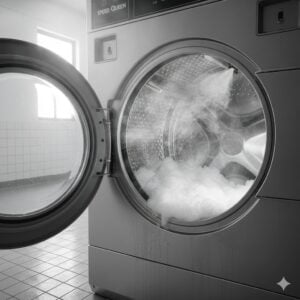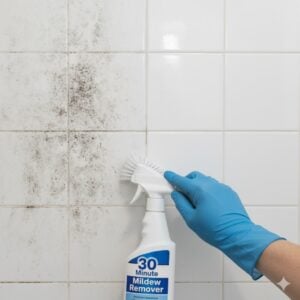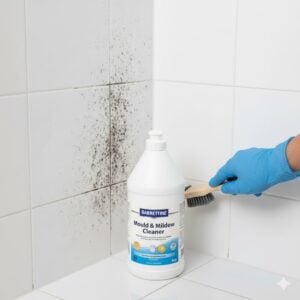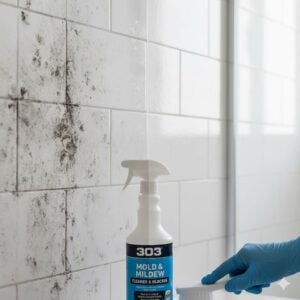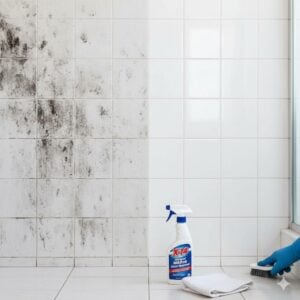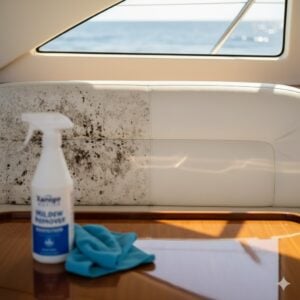Noticed damp patches or bubbling paint at home? Moisture on the wall is more than a cosmetic issue—it’s a warning sign. In the UAE, cool indoor air from AC systems meets warm, humid outdoor conditions, and that temperature clash often drives condensation inside apartments and villas. Add small plumbing leaks or trapped humidity, and you’ve got the perfect setup for damp walls, musty smells, and eventually mold. In this guide, we explain why it happens, how to diagnose the cause, what damage it can do, and the exact steps you can take to fix it and stop it from coming back.
Table of Contents
Toggle1) Why walls get wet in the UAE
Moisture appears when water finds its way into the wall, or when water in the air turns into liquid on the wall. The first is an infiltration problem (leaks), the second is a condensation problem (dew point). In our climate, you’ll often see both.
Common UAE-specific causes:
- Condensation from AC: Rooms are chilled quickly. When warm, humid air hits a cold wall surface, water condenses and forms damp patches—especially on exterior walls, behind wardrobes, and near AC vents.
- Hidden plumbing leaks: Pin-hole leaks in supply lines, slow seepage from shower niches, or failed silicone/grout in bathrooms and kitchens.
- Building envelope issues: Hairline cracks, poor exterior sealant, or roof/terrace membrane failure letting rain or irrigation water migrate through the structure.
- Thermal bridges: Concrete columns and beams that get colder than surrounding areas; moisture shows as vertical “ghosting” lines or corner damp.
- Low ventilation: Sealed windows keep cool in—but also trap humidity from showers, cooking, and clothes drying.
2) Signs to watch for (and what they usually mean)
Reading the signs helps you decide whether you’re dealing with condensation, a plumbing issue, or water ingress from outside. Here’s a quick guide:
| Sign | What it often indicates |
|---|---|
| Damp rings or patches that change size with weather/AC | Condensation or exterior moisture sensitivity |
| Localized damp on a wall behind a shower or sink | Possible plumbing leak or failed waterproofing |
| Bubbling/peeling paint, powdery white deposits (efflorescence) | Salts migrating with water—longer-term moisture movement |
| Dark corners, black/green spots, musty smell | Active mold growth due to persistent humidity |
| Vertical/corner “cold lines” that always feel cooler | Thermal bridge causing repeated condensation |
Tip: If a patch feels cool to the touch compared to the rest of the wall, condensation is likely involved. If the patch is warm and damp near plumbing lines, suspect a leak.
3) Quick tests you can do today

Before calling anyone, a few simple checks can narrow the cause:
The foil test (condensation vs. ingress): Tape a small piece of kitchen foil flat against the damp area and leave it for 24 hours. If the side facing the room gets wet, moisture is from the air (condensation). If the wall-facing side gets wet or the foil edges show dampness seeping through, water may be coming from inside the wall (leak or ingress).
Hygrometer check: Place a small digital hygrometer in the room. Indoor humidity consistently above ~60% invites condensation and mold. Bathrooms and kitchens easily spike without exhaust fans.
AC filter & drain inspection: Dirty filters or blocked condensate drains push humidity back into rooms. Clean or replace filters monthly and ensure the drain is flowing.
Wardrobe clearance: Move furniture 5–8 cm off exterior walls for a week. If the damp improves, stagnant air and condensation were likely drivers.
4) What happens if you ignore wall moisture
Leaving damp walls “for later” costs more in the end. Here’s why:
Mold growth: Moisture feeds spores. Once mold colonizes paint film or gypsum board, you’ll see spreading stains and smell mustiness. That affects indoor air quality and can trigger allergies and asthma—especially for kids and older adults.
Finish failure: Blistered paint, sagging skim coats, crumbling plaster, swollen MDF skirtings, rusting nails or corner beads—repairs get messier and pricier the longer moisture stays.
Hidden structural issues: Persistent ingress can rot timber elements, corrode reinforcement, and weaken adhesives behind tiles or stone cladding. At that point, you’re looking at removal and reinstatement, not just repainting.
5) A practical, step-by-step fix
Below is a simple plan you can follow. For light condensation, you can do most of it yourself. For leaks or mold, bring a professional in early.
- Stabilize the room climate: Run the AC at a moderate setpoint (23–24°C), use “dry” mode if available, and keep doors/windows closed while cooling. Add a dehumidifier in problem rooms and run it to 50–55% RH.
- Vent daily: After showers or cooking, run exhaust fans 20–30 minutes. If safe, crack a window briefly during cooler hours.
- Dry the surface: Use fans to move air along the wall. Avoid trapping moisture with plastic coverings or stacked boxes.
- Clean safely: If there’s light mildew, wipe the area with a gentle, non-scented cleaner or a diluted biocidal solution suitable for painted surfaces. Wear gloves and a mask. Do not saturate the wall.
- Check plumbing & sealants: Inspect silicone/grout in showers, under-sink traps, and washing machine connections. Replace cracked silicone and re-grout where needed.
- Repair and repaint (when fully dry): Scrape blisters, sand smooth, spot-prime with a stain/mold-blocking primer, then repaint with a high-quality, washable low-VOC interior paint with anti-mold additives. If thermal bridging is severe, consider an insulating primer or thin interior insulation board (where practical).
Important: If mold is widespread (>1 sq.m.), if you see repeated wetness in dry weather, or if the wall feels soft/crumbly, pause DIY. You likely have a leak or chronic ingress that needs professional remediation.
6) When to call a professional (and what we do)
Bring in help if any of the following is true:
- The same damp patch keeps returning after cleaning and repainting.
- There’s visible mold larger than a handprint, or strong musty odor.
- Bathrooms share a wall with the damp area, or there’s a ceiling stain below a wet room.
- You see efflorescence, widespread bubbling, or delamination of plaster/paint.
How we help: We start with moisture mapping (including high-risk corners and seams), inspect AC drains/filters, and look for leak paths. If needed, we can arrange advanced tests (air quality, surface scraping, PCR, mycotoxin, humidity/pH)—useful for chronic mold complaints. Once the cause is confirmed, we dry, treat, and restore, then give you a simple prevention plan tailored to your space.
If mold is present, our remediation pricing is transparent and area-based. If you want a precise quote for your wall, just click the contact button on the right-middle of this post and we will guide you through next steps.
7) Preventing moisture from coming back
Think “airflow + temperature + time.” Small changes compound into big wins:
Space furniture off walls: Even 5–8 cm allows air to wash the surface, reducing cold spots and condensation. Add breathable wardrobe backers if closets sit on exterior walls.
Balance AC: Extremely low setpoints create colder walls and more condensation. Aim for comfort, not “coldest possible.” Keep filters clean; clear the condensate drain.
Control indoor humidity: Don’t air-dry laundry in closed rooms. Use lids while cooking. Run bathroom fans long enough to clear steam, not just during the shower.
Maintain seals: Re-silicone shower trays and kitchen splash zones yearly if needed. Renew grout where it’s cracked. Small upkeep prevents big leaks.
Choose smarter finishes: In high-risk areas, prefer washable, mold-resistant interior paints and primers. Where feasible, reduce thermal bridges with insulating underlayment or consider anti-condensation coatings.
8) FAQs we get all the time
“Can I just paint over a damp wall?” Not safely. Trapped moisture will blister the new paint and may grow mold underneath. Dry it, fix the cause, prime, then repaint.
“Dehumidifier or AC—what’s better?” Together is best. AC lowers air temperature and removes some moisture; a dehumidifier specifically targets humidity to a set RH.
“How long until a damp wall dries?” From hours to weeks, depending on the cause and material. Condensation dries quickly with airflow; water ingress can take much longer and needs the source fixed first.
“Do I need lab tests?” Only for chronic or health-sensitive cases. Most moisture problems resolve with solid diagnostics, drying, and repairs. Lab work is helpful when symptoms persist or sensitive occupants are involved.
Conclusion
Moisture on the wall is your home’s way of asking for help. Sometimes the fix is simple—better airflow and a sensible AC setpoint. Other times, a hidden leak or thermal bridge needs professional attention. Either way, acting early saves your paint, your air quality, and your budget. If you’d like a clear plan for your specific wall, click the contact button on the right-middle of this post. We’ll help you diagnose the cause, dry it out, and keep it from coming back—so your walls stay clean, healthy, and dry.








